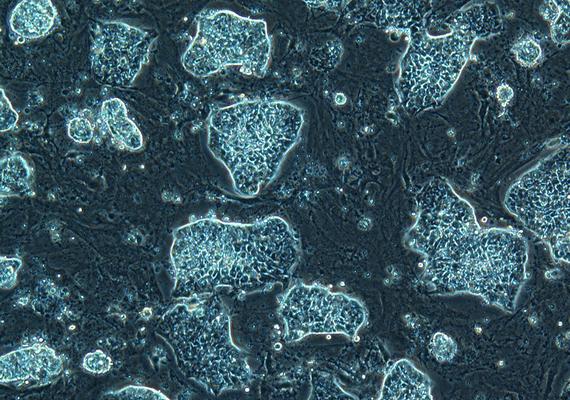ES Cell Services
Contact us:
Shiying Liu sliu@ucalgary.ca Genotyping, Cell Culture, Supplies
General questions at transgen@ucalgary.ca

ES Cell Services
Gene Targeting
We offer a number of services to accommodate your ES cell mutagenesis/transgenesis requirements including genotyping, cell culture assistance and ES line derivation.
ES Cell Services
Reprogramming
We have used the integration–free Sendai reprogramming kit to induce human fibroblasts and peripheral blood mononuclear cells (PBMC) into pluripotent stem cells. The obtained iPSCs express pluripotent markers, can differentiate into the three germ layers and have normal karyotyping. After 4 passages, the Sendai viruses and vectors are eliminated.
Characterization
iPSCs
a. Detection of pluripotency markers of iPSCs : Oct 3/4, Sox2, TRA-1- 60, Nanog, SEA4
b. Examine the potential differentiation ability of iPSC by In vitro differentiation
c. Karyotyping iPSCs with G-banding and manually pair up the chromosomes
Gene Targeting
We offer a number of services to accommodate your ES cell mutagenesis/transgenesis requirements. Your gene of interest may have already been mutated or conditionally disrupted via the numerous ES cell gene trapping (IGTC: http://www.genetrap.org/) and gene targeting (KOMP: http://www.komp.org/) resources that currently exist. If you are so lucky, we can assist you in acquiring the construct or ES cell line and preparing it for 8-cell embryo microinjection by Transgenic Services. If you need to target a transgene to the HPRT locus or disrupt your own gene, we can assist you with planning your targeting vector.
Full Service Fee includes:
- Preparation of MEF feeder plates
- Preparation of ES cells
- Electroporation/Nucleofection
- Positive/negative selection
- Isolation of ES cell clones (100-300)
- -80oC freezing of duplicate multiwell dishes
- Preparation of 96 well plates ES cell clones for genomic DNA purification and genotyping
- Expansion of positive clones
- LN2 storage of positive clones in cryovials
- Karyotyping confirming euploidy
Guidelines
-
Gene targeting strategies include conditional 'floxed' alleles and generation of point mutations.
-
Gene targeting vectors should be based on genomic DNA that is isogenic to the mouse ES cell line that will be used in gene targeting experiments. It is not reccomended to use PCR to construct the vector as polymerases can introduce polymorphisms which lower targeting efficiency or mutations which compound the phenotype
-
The total amount of chromosomal homology is usually recommended to be between 8 to 10 kb. It is wise to have a short arm (~2kb) and a long arm (~8kb). The short arm can be conveniently used to position the flanking probe that is used to identify the targeted allele. It is not wise to use less than a 1.5kb short arm as this can lead to non homologous recombination of the short arm.
-
A neomycin phosphotransferase (neo) cassette with a suitable mouse gene promoter and polyadenylation sequence is used as a positive (G418) selectable marker. This neo cassette can be flanked by loxP sequences for subsequent removal by Cre recombinase.
-
An HSV-TK cassette which flanks one or both of the homology arms can be used for negative selection using gancyclovir or FIAU.
-
A unique restriction enzyme site outside the homology region must be used as the site of linearization of the targeting vector plasmid. In the case of phage targeting vectors, the arms must be excised from the targeting vector proper.
-
In order to identify gene targeting events a unique restriction enzyme site should be introduced by the positive selection cassette to use in a genomic Southern Blot using a probe external to the short arm homology region. It is imperative that this genomic Southern be worked out prior to initiating the gene targeting experiment.
Other Services
Ploidy analysis: As diploidy is needed for germline transmission success, we offer an optional ploidy analysis.
Cre excision: We can pursue a cre deletion experiment in ES cells.
MEF derivation: We can generate Mouse Embryonic Feeders (MEFs) from your favorite mouse mutant.
ES cell line derivation: We can derive novel ES cell lines from your favorite mutant mouse.
ES cell line expansion: We can receive and expand cell lines coming from other laboratories.
ES cell sub-cloning: We offer ES cell subcloning to enrich for undifferentiated or diploid cells.
Custom projects: We can perform individualized ES cell culture for your specific project. For example, we can assist you with differentiating ES cells into your favorite cell type of interest.
Mycoplasm Testing: We can confirm whether your cell lines have been contaminated with mycoplasm.
Supplies & reagents: We offer ES cell culture tested supplies, reagents and cells including primary CD1, DR4, pPGKneo Mefs or mitomycin inactivated DR4, pPGKneo Mefs. As well LIF, ES cell tested FBS and other supplies can be purchased from us.
Contact us:
Shiying Liu - sliu@ucalgary.ca (questions regarding the ES Cell Facility or services and supplies)
General Inquiries - transgen@ucalgary.ca
CGE Home Page
Supporting investigators by delivering a comprehensive turn-key service incorporating all of the necessary tools to create, analyze and cryopreserve transgenic mice.
Molecular Services
Offering designing, construction and preparation of vectors for the generation of genetically engineered mice.
Transgenic Services
Offering a comprehensive list of transgenic services including rederivation, cryopreservation and line rescue.
